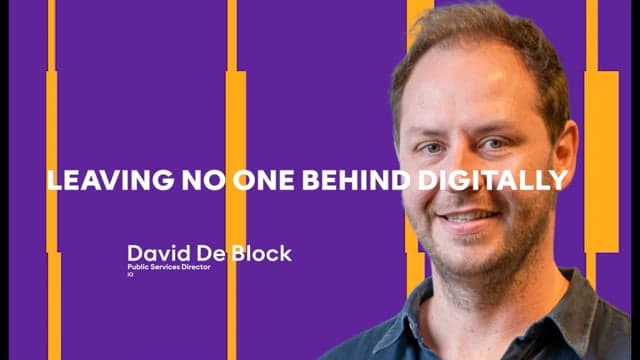
Webinar
E-inclusion: how to leave no one behind digitally
There is a digital divide between the personas we use in marketing and the population. In Belgium, this gap is large: almost 50% of the population are considered to be digitally vulnerable. How do you deal with this as an organisation? And how do you ensure that your products and services do not exclude anyone digitally? This blog contains nine practical tips to help you on your way to digital inclusion.

The importance of e-inclusion
For people today, 40 years old is anything but old and are a world away from being written off. But most digital experiences are modelled with the younger generations in mind. Older people and the less well-educated are more likely to be digitally vulnerable. But the story is more complex than that. Digital vulnerability is not just a matter of demographic factors. In fact, anyone can be digitally vulnerable. For example, this category includes one in three young people between the ages of 16 and 24, and 23% of people with a higher education degree. That's why it's important to deliver inclusive products and services that appeal to everyone — not just the people who have every opportunity in terms of technology.
“How can organisations deal with the challenge of digital vulnerability in almost half the population? The answer lies in the principle of e-inclusion: designing for real people, not just personas.”

David De Block, Public Services Director, iO
Review David De Block's keynote

The right message, in the right 'accessible' way, through the right channels remains crucial. In his keynote at the BAM Marketing Congress, David De Block (Public Services Director at iO) talks about e-inclusion -- or what it means to leave no one behind.

Inclusion in three domains
When it comes to e-inclusion, there's one crucial principle: design for real people, not personas.
You may already have people on your team who are ready to get started with e-inclusion — think UX designers, copywriters, developers, and graphic designers.
Making progress is more important than doing everything perfectly the first time. To get started with e-inclusion, it's best to take a pragmatic approach. Implementing incremental improvements and building on your existing successes.
We’ve identified three key areas where small improvements can have a big impact on e-inclusion. These domains are:
1. User experience design
2. Service design
3. Change management.
There is a lot of progress to be made in terms of user experience, but the implementation sometimes leaves a lot to be desired. This is how you make the user experience of your services and products more inclusive:
Research and testing with real people: The perfect persona doesn't exist in real life. Therefore, carry out user tests with real people so that you can find out which problems you can solve for them
Use clear language: Texts with easy to understand, everyday language is more likely to be understood by your target group. It's not a matter of dumbing down your texts, but of opening up your communication to a wider group of people
Be accessible: 71% of customers with accessibility needs click away from websites they find difficult to use. Follow web accessibility guidelines to remove barriers and make your platform usable by a wider audience.
Accessible travel advice for everyone
It is best to make new and existing services as human as possible — and they should also be aligned with your organisation’s goals. Here's how to make service design more inclusive:
Address technical debt: A complex UI is often the result of complex underlying systems, both technical and organisational. Analyse the impact of technical debt and identify what needs to change to move forward
Design for stress cases, not best cases: Make sure your services and products aren't just practical in the ideal scenario. Even — and especially — at more difficult moments, users need to be able to navigate your digital services easily
Implement a two-track policy: Digital inclusion is all about leaving no one behind. So also provide an alternative for people who can't use your digital solutions.

Do you want to implement relevant changes that help your organisation, your employees, your customers, and your partners move forward? Naturally! But make sure you do it the right way — read: in a digitally inclusive way. Here's how to make change management more inclusive:
Build empathy: Record user tests and show the videos to your senior management and employees. This way, your teams can build empathy with the target audience — digitally vulnerable or not
Start small: You can't make impactful changes overnight. Start with small short-term victories and create a broader support base
Digital inclusion by design: Inclusion was one of the design principles of Tim Berners Lee, the creator of the world wide web, from the beginning. It is high time we did something about it.
Do you want digital inclusion for all?
More than 4 in 10 Belgians are being left behind digitally. It is essential that brands, businesses and government institutions are aware that digital skills inequality and poor access to digital services is widespread and we have to take these accessibility factors into consideration in every digital design and creation process. Get to work with our digital and strategic experts on digital inclusion.